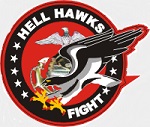Hobby Master HA8215 USMC Chance-Vought F4U-1 Corsair Fighter - James N. Cupp, VMF-213 "Hell Hawks", Guadalcanal, Solomon Islands, 1943 (1:48 Scale)
"Why should we have a navy at all? There are no enemies for it to fight except apparently the Army Air Force."
- General Carl Spaatz, Commander of the US 8th Army Air Force, after WWII
 Its gull-wing shape made it instantly recognizable. Its characteristic sound while in an attack dive led the Japanese to call it "The Whistling Death." Combined with its high speed, agility and toughness, the Vought F4U Corsair was one of the finest fighters ever built. Originally thought to be too powerful to fly from a carrier, the Corsair weaved a path of destruction in battle after battle during WWII, totally outclassing the much-feared Zero. The last of the great piston-engine fighters, the Corsair went on to become an important component of the US naval air power during the Korean War. Even while it was being replaced by jet aircraft, pilots flying this tough warbird were credited with downing a few MiG-15 jet fighters.
Its gull-wing shape made it instantly recognizable. Its characteristic sound while in an attack dive led the Japanese to call it "The Whistling Death." Combined with its high speed, agility and toughness, the Vought F4U Corsair was one of the finest fighters ever built. Originally thought to be too powerful to fly from a carrier, the Corsair weaved a path of destruction in battle after battle during WWII, totally outclassing the much-feared Zero. The last of the great piston-engine fighters, the Corsair went on to become an important component of the US naval air power during the Korean War. Even while it was being replaced by jet aircraft, pilots flying this tough warbird were credited with downing a few MiG-15 jet fighters.
Pictured here is a 1:48 scale replica of a USMC Chance-Vought F4U-1 Corsair fighter that was piloted by James N. Cupp, who was attached to VMF-213 "Hell Hawks" during 1943.
Sold Out!
Dimensions:
Wingspan: 10-inches
Length: 8-1/4-inches
Release Date: January 2017
 Historical Account: "Double Ace" - James Norman Cupp (March 28th, 1921 - June 2nd, 2004) was a United States Marine Corps aviator during World War II. Cupp was a double flying ace with at least 12 aerial victories in the Solomon Islands during three months of World War II. He was a recipient of the Navy Cross, the Navy's second highest military decoration for valor and was a four time recipient of the Distinguished Flying Cross. Also a Korean War veteran, he retired as a Colonel to Manassas, Virginia in 1968.
Historical Account: "Double Ace" - James Norman Cupp (March 28th, 1921 - June 2nd, 2004) was a United States Marine Corps aviator during World War II. Cupp was a double flying ace with at least 12 aerial victories in the Solomon Islands during three months of World War II. He was a recipient of the Navy Cross, the Navy's second highest military decoration for valor and was a four time recipient of the Distinguished Flying Cross. Also a Korean War veteran, he retired as a Colonel to Manassas, Virginia in 1968.
Cupp was attached to VMF-213, the Hell Hawks, in September 1942 at Marine Corps Air Station Ewa and later flew the Vought F4U Corsair. He had his crew paint Daphne "C", for his wife, on the engine cowling of his Corsair. He arrived at the Solomon Islands for his first combat tour on April 3rd, 1943. Cupp scored his first aerial victory on July 15th, 1943 and was an ace three days later. During his tour he was credited with 13-1/2 or 13 aerial victories based on reports by his wingmen. According to Guttman (2005), he was officially credited with 12 victories.
On September 20th, 1943, Captain Cupp was shot down by a G4M1 Betty, north of Kolombangara, using an improvised gun unexpectedly mounted in its bomb bay and he was severely burned. Badly injured, he spent the next 18 months in hospitals, primarily Oak Knoll Naval Hospital in Oakland, California. After that he served as a Naval Flight instructor. The war ended before he could return to the Pacific theater.






